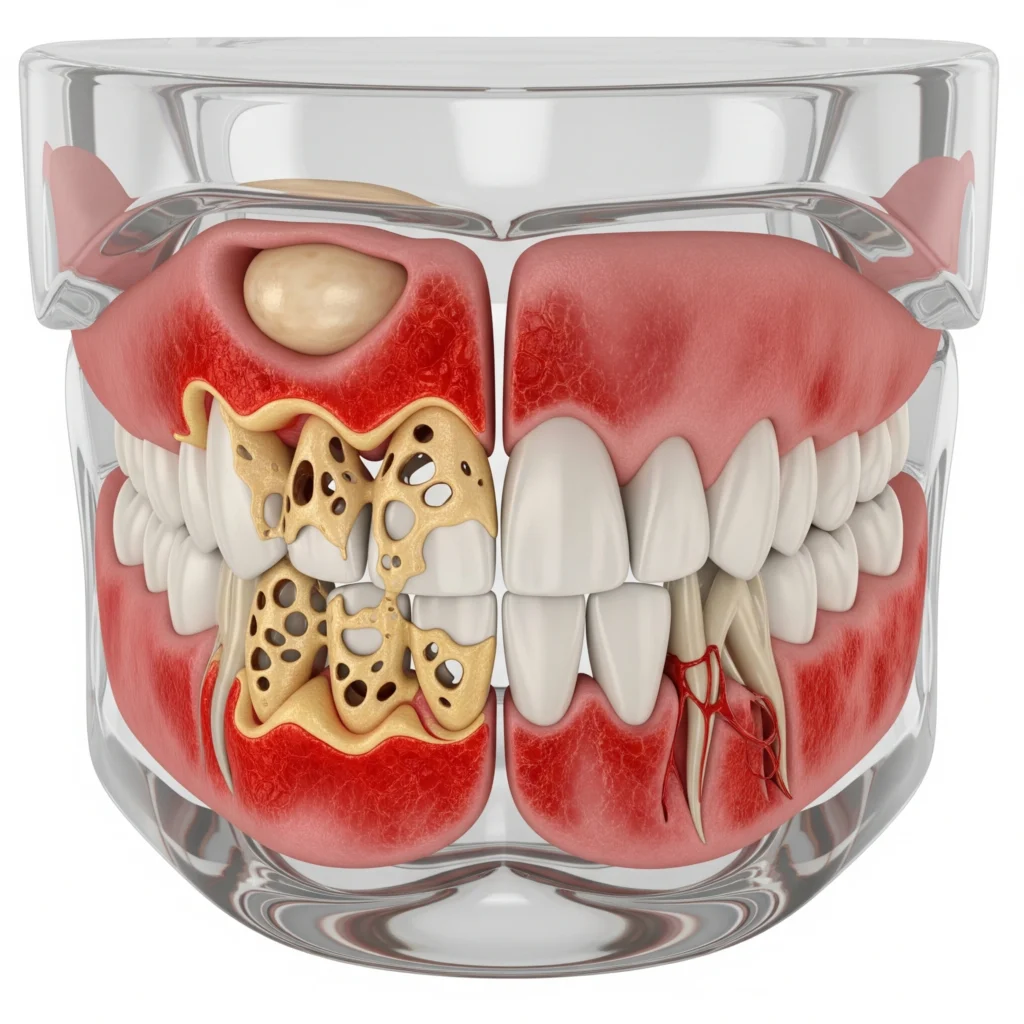Osteomyelitis of the jaw is a severe infection impacting the bone and marrow in the jaw region. If untreated, it can cause inflammation, intense pain, and bone damage. Understanding the causes, symptoms, and treatment methods for osteomyelitis of the jaw is essential for early diagnosis and effective management. Early intervention improves recovery and helps prevent complications, which makes awareness crucial.
In this article, we will explore the primary causes of osteomyelitis of the jaw, discuss common symptoms, outline treatment options, and provide helpful prevention tips. Additionally, we will touch on related topics like jaw bone infections and maxillary osteomyelitis to ensure comprehensive knowledge on this subject.
Osteomyelitis is an infection of the bone, usually caused by bacteria or fungi that invade through an open wound, tooth infection, or surgical site. When it affects the jaw, the infection can involve either the upper jaw (maxilla) or lower jaw (mandible).Infection of the jaw bone leads to inflammation and can cause damage to the bone tissue..
Usually, the infection reaches the jaw through the bloodstream or from nearby infections such as dental abscesses or periodontal disease. People with weakened immune systems, chronic illnesses like diabetes, or recent dental surgery are at higher risk of developing osteomyelitis of the jaw.

Several factors can lead to osteomyelitis of the jaw. The most common include:
1. Dental Infections and Trauma
Dental abscesses caused by untreated cavities or gum disease are primary causes. Trauma to the jawbone during accidents or dental surgeries can also introduce bacteria leading to infection.
2. Poor Oral Hygiene
Inadequate oral care increases bacterial growth, causing infections that may spread to the bone. Chronic gum diseases like periodontitis are often linked with jaw osteomyelitis.
3. Compromised Immunity
Patients with diabetes, cancer, or those undergoing chemotherapy have weakened immune defenses. This makes them vulnerable to bacterial infections, including those affecting the jawbone.
4. Radiation Therapy
Radiation treatments for head and neck cancers can damage bone tissue and reduce blood flow, increasing the risk of osteomyelitis.
Identifying the symptoms of osteomyelitis of the jaw early can greatly improve treatment outcomes. Common symptoms include:
Since these symptoms overlap with other dental conditions, consulting a dental professional promptly is necessary for an accurate diagnosis.
To diagnose osteomyelitis of the jaw, a combination of clinical examination and imaging techniques is used. Dentists or oral surgeons may recommend:
Early diagnosis helps in selecting the most appropriate treatment plan, avoiding severe complications.
Treating osteomyelitis of the jaw usually requires a combination of medical and sometimes surgical interventions. The primary aims are to eradicate the infection, decrease inflammation, and recover jaw function.
1. Antibiotic Therapy
|Long-term antibiotics are the cornerstone of treatment. Usually, intravenous antibiotics are administered initially, followed by oral antibiotics for several weeks. The choice of antibiotic depends on the bacteria identified through cultures.
2. Surgical Intervention
Surgical intervention might be required to excise dead or infected bone tissue (debridement). In severe cases, bone grafting might be needed to restore jaw structure. Surgery also helps drain abscesses and prevent the spread of infection.
3. Supportive Care
Pain management, proper nutrition, and hydration are essential during recovery. Keeping excellent oral hygiene is just as crucial to avoid recurrence.
Preventing osteomyelitis of the jaw involves several practical steps to maintain oral health and reduce infection risks:
By following these measures, you can significantly lower your chances of developing jaw bone infections.
Recovering from osteomyelitis of the jaw requires patience and compliance with medical advice. Regular follow-ups with your healthcare provider ensure the infection is fully resolved. Additionally, adopting a healthy lifestyle supports your immune system and promotes healing.
Stress reduction, adequate sleep, and a balanced diet rich in vitamins and minerals help strengthen your body’s defenses against infections. Furthermore, avoid self-medicating or discontinuing antibiotics prematurely, as incomplete treatment may lead to recurrence.
Maxillary osteomyelitis refers to infection specifically affecting the upper jawbone. Though less common than mandibular osteomyelitis, it shares similar causes and symptoms.Timely diagnosis and intervention are crucial to avoid severe complications.
Osteomyelitis of the jaw is a critical condition that demands prompt medical care.Recognizing early symptoms, seeking prompt diagnosis, and adhering to prescribed treatments are vital steps toward full recovery. With advances in dental care and infection control, most patients respond well to treatment and regain normal jaw function.
If you experience persistent jaw pain, swelling, or other related symptoms, do not hesitate to consult a dental specialist. For expert diagnosis and personalized treatment plans, visit Unidental, the Best Dental Hospital in Hyderabad, where advanced care meets compassionate service.
Yes, if caused by HSV-1, they are highly contagious, especially during the blister stage. Avoid close contact until fully healed.
Most blisters heal within 7–14 days, though antiviral treatment can shorten recovery time.
Yes, stress can weaken the immune system, triggering the reactivation of dormant herpes viruses.
No, cold sores appear outside the mouth and are caused by a virus, while canker sores occur inside the mouth and are not contagious.
Avoid spicy, acidic, or salty foods, as well as touching or picking at the blister, which can delay healing and spread infection.
Hyderabad : +91 6305 971445
Anantapur: +91 70758 90089
Goa: +91 83266 32500
Mon to Sat 10:00AM to 8:00PM
Sun 10:00AM to 12:00PM
Lorem ipsum dolor sit amet, consectetur adipiscing elit. Ut elit tellus, luctus nec ullamcorper mattis, pulvinar dapibus leo.

Our goal is to provide friendly, caring dentistry with the highest standards in general, cosmetic, and specialist treatments. We strive to be the best dental hospital for comprehensive oral care.
We use advanced dental technology to deliver safe, precise, and painless treatments for every patient.